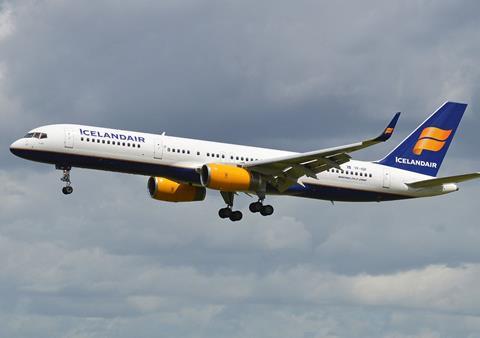Icelandic investigators probing a low-fuel situation involving an Icelandair Boeing 757-200 in October 2019 found weaknesses in the ability of the country’s airports to handle a diversion.
The aircraft, inbound from Seattle, had been conducting its approach to Reykjavik Keflavik airport’s runway 01 when a BAe 125 executive jet experienced an excursion while landing on the same runway.
This closed the runway and, since the airport’s runway 10/28 had not been maintained overnight, effectively shut Keflavik to traffic.
The aircraft was instructed to hold at 6,000ft at the SOPAR waypoint to the south of the airport.
Icelandic investigation authority Rannsoknarnefnd Samgonguslysa, in a 7 December final report, says the crew discussed the situation, noting that they did not have much fuel for holding, and asked Keflavik approach control about braking action at the smaller regional Reykjavik airport – the flight’s designated alternate.
Although braking measurements had already been performed twice at Reykjavik, this was not known to Keflavik approach, and the crew was informed that obtaining the braking information would take half an hour.
The 757’s crew responded that this was too long to wait, given the fuel status, and that landing at Keflavik was the only option.

While the flight was cleared for approach to runway 01, Keflavik tower controllers were not willing to give landing clearance – owing to the BAe 125 excursion – unless the crew declared an emergency.
Keflavik approach subsequently transmitted the braking figures for Reykjavik, about 8min after the crew’s initial request, but the crew continued the descent to Keflavik and declared an emergency. The 757, at this point, had 2.8t of fuel remaining.
Tower controllers cleared the aircraft to land on runway 01, despite its being closed, and the aircraft touched down with 2.6t of fuel, about 1t above the final reserve quantity of 1.66t.
The crew and passengers of the BAe 125 had still been on board the jet, at the far end of runway 01, and were not informed of the 757’s approach.
But the 757’s landing was uneventful and it exited to taxi to the parking gate. Upon arrival the aircraft had 2.4t of fuel.
Although the incident was successfully resolved, investigators conducted analysis of the diversion scenarios.
If the 757 had continued to hold at SOPAR until Keflavik’s runway re-opened, about 54min after the holding instruction, the jet would have burned another 2.15t of fuel, leaving around 0.4t on landing.
Diverting to Reykjavik when the braking measurements were transmitted to the crew would have led to a landing with 1.8t of fuel, still above the final reserve. But performance calculations, using the ‘medium’ braking action provided to the crew, showed that the 757 “could not land” at Reykjavik, says the inquiry.
The analysis found that, while various parties had operational safety nets, they were “only looking at it from their point of view and not from the whole systematic point of view”, leading to “gaps” in the safety systems between them.
Given the opening hours of Reyjkavik airport, and the time needed to upgrade rescue and landing capabilities, it was “not a good choice” of alternate for the flight.
It adds that multiple transatlantic services arrive at Keflavik at a time when all the other Icelandic international airports – Reykjavik, Akureyri and Egilsstadir – are closed, and each would experience difficulty achieving the necessary level of readiness in the short time available during a diversion from Keflavik.


























